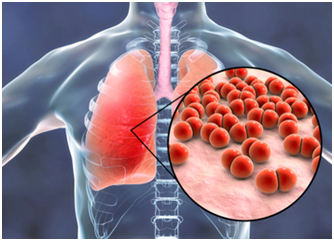COPD can worsen the symptoms of pneumonia and weaken the body’s immune response. Identifying triggers and seeking medical help is critical

Despite its rather benign name, Pneumonia is a veritable killer. According to a report by the World Health Organization (WHO), it accounted for more than 15% of the deaths of all children in 2017. Despite multiple concerted efforts to eradicate it, the disease has always persisted.
India’s tropical climate and high pollution levels have provided ideal conditions for it to thrive as have poor sanitation and healthcare. COPD, while being a mouthful, can be just as deadly. Patients with chronic COPD have even lower chances of survival than certain types of cancer.
Are COPD and pneumonia connected?
Pneumonia is a respiratory disease that targets the air sacs of the lungs. It causes fluid to accumulate in them, making breathing difficult. It also has several other debilitating effects such as mental confusion, chills, fatigue and nausea. Left untreated, it can lead to respiratory failure and even death.
COPD or Chronic Obstructive Pulmonary Disease (COPD) can be easily confused with pneumonia as it shares many of its symptoms. COPD also affects lung function, causing inflammation and laboured breathing. Reduced immune function in COPD patients makes them susceptible to disease-causing viruses, bacteria and fungi.
COPD weakens the immunity of the respiratory system, allowing other infections such as pneumonia to take root. However, pneumonia is the deadlier of the two.
What happens when you have COPD and pneumonia?
To understand COPD and its close relationship with pneumonia, let us take a look at what happens in the body countless times as you breathe.
Upon inhalation, air travels through the windpipe known as the trachea. It enters the lungs via two tubes called the bronchi. These further taper into smaller branches called bronchioles, culminating into alveoli -- tiny groups of air sacs.
The air sacs absorb oxygen via the tiny blood vessels in their membranes or walls. This oxygen eventually goes into the bloodstream. As you exhale, carbon dioxide is released and eventually finds its way out of the nostrils.
Two distinct conditions – emphysema and bronchitis -- inhibit the natural functioning of the lungs. These are collectively known as COPD. While bronchitis affects the tubes of the lungs, emphysema - like pneumonia - affects its air sacs.
Distress in the respiratory system can affect the heart, pancreas and adrenals due to the lack of oxygen, a condition known as hypoxia.
What are the symptoms of COPD?
The following are tell-tale signs to look out for:
- Difficulty in breathing
- Wheezing
- Tightness in the chest
- Regular coughing
- Excess mucus
- Discoloration of lips
- Fatigue
- Weight loss, without any apparent reason
- Swelling in the feet, legs or ankles
If you have had any of these symptoms for more than a week, a visit to your doctor is advised. Early detection can significantly improve your chances of a faster recovery.
What causes COPD?
- Lifestyle habits
One of the primary reasons for COPD is smoking. Passive smokers are equally at risk; almost 20% of COPD patients are reported to have never smoked in their lives.
Smokers are more likely to have a drinking problem than the average population. Research suggests that drinking affects the diffusing capacity of the lungs and impacts glutathione, a key antioxidant that is responsible for maintaining lung health.
- Environmental causes
Dropping air quality levels due to organic and inorganic pollution is another cause, although it is not as pronounced. Reports from Punjab and Haryana indicate a marked increase in COPD attacks -- known as exacerbations -- particularly during the post-harvest season.
The reason: rampant burning of paddy stubble, giving rise to excessive levels of smog that affects visibility for miles, triggering health hazards. Allergens and other irritants such as dust, mites and moulds can aggravate pneumonia and asthma -- another close cousin of COPD.
In addition, the abundance of Particulate Matter (PM) in the air is another important cause.
How can COPD be treated?
The cost to the global economy due to COPD and pneumonia has been estimated to be in millions of dollars. This challenge needs a holistic response, at both the primary health care level as well as policy level. Awareness about COPD is only the first step.
While there is no permanent cure for COPD, treatment can allay the symptoms, avert complications and slow down progression of the disease.
- Medications
These include bronchodilators that help to relax airway muscles. Usually, a nebulizer is used to administer these.
- Oxygen Therapy
Guided breathing is also a possibility, particularly if reports indicate reduced oxygen levels in the blood.
- Surgery
This is usually the last resort, one that is reserved for when all medications have failed. Your doctor might recommend a surgery should you be suffering from severe emphysema. One type of surgery is bullectomy, a procedure whereby abnormal air spaces in the lungs are surgically removed.
A COPD and pneumonia prognosis usually involves a course of antibiotics and steroids depending on the severity.
In addition, introducing lifestyle changes (stubbing the cigarette, exercising moderately as per doctor’s recommendations and sticking to a healthy nutrition plan) is always a good place to start. This can ease the symptoms, and bring considerable relief.
For all the advancements in technology and modern medicine, treatment of COPD and pneumonia can cost you thousands in a leading healthcare facility. A comprehensive health insurance can be your financial cushion during such an emergency. This way, you can stay insulated from a potential drain on finances.
Importantly, you can access cashless medical care and benefit from a prompt claims settlement process, ensuring ready financial aid in times of hardships.
Related Article:
Monsoon and Malaria: A Deadly Combination
Protect Yourself against the Deathly Dengue Virus